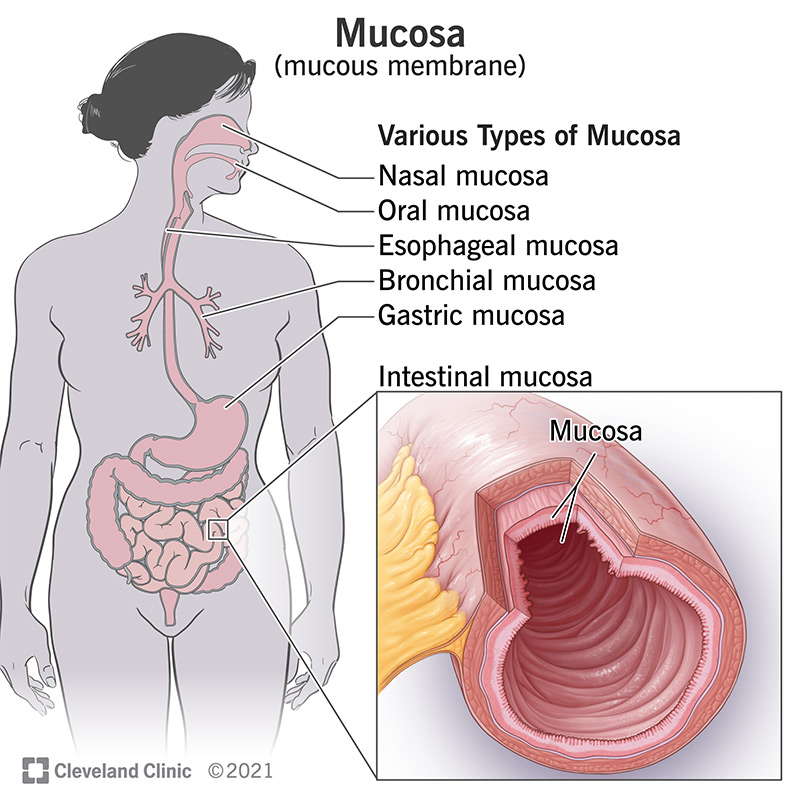Mucosa is the soft tissue that lines the body’s canals and organs in the digestive, respiratory and reproductive systems. It’s also called the mucous membrane. Mucosa has three layers: epithelium, lamina propria and muscularis mucosae. It plays an important part in immunity.
Advertisement
Cleveland Clinic is a non-profit academic medical center. Advertising on our site helps support our mission. We do not endorse non-Cleveland Clinic products or services. Policy
Mucosa is another name for mucous membrane. Mucosa lines the insides of organs and cavities throughout your body that are exposed to particles from the outside. The mucous membrane lubricates and protects these organs and cavities from abrasive particles and bodily fluids, as well as invasive pathogens. You have more than 200 times more mucosa than skin, making it your body’s largest protective barrier. It’s also involved in absorption, especially in the gastrointestinal tract, where it plays a role in digestion.
Advertisement
Cleveland Clinic is a non-profit academic medical center. Advertising on our site helps support our mission. We do not endorse non-Cleveland Clinic products or services. Policy
Mucosa has three layers:
The epithelial layer is the surface layer of the mucosa. Epithelial cells secrete a thick, gel-like mucus that protects your body from irritants and gives the mucosa its name. These cells arrange themselves in different ways to suit different parts of your body. There may be one or several layers of cells, and they may be stacked in columns or laid like bricks. They also have a high cell turnover rate, replacing themselves often while clearing out invasive particles. Some have tiny hairs called cilia, which help remove foreign substances.
The epithelium attaches to a loose connective tissue called the lamina propria. This is the middle layer of the mucosa. The lamina propria is composed of structural protein molecules, nerves and veins. It carries blood supply to the epithelium while holding the cells in place and binding them to the smooth muscle below. Its nerves respond to muscle fluctuations by squeezing and stretching to change the shape of the epithelium as needed. It also hosts a variety of immune cells that seek out and destroy pathogens.
The deepest layer of the mucosa is the muscularis mucosae, a layer of smooth muscle. It varies in thickness throughout the digestive tract and is most active in your stomach. The muscularis mucosae appears to provide a perpetual motor function that keeps the mucosa in flux. This may help the mucosa to stretch and contract along with the various organs of the digestive system as they do their jobs. It may also help the mucosa perform its cleansing functions by keeping the hair-like cilia on the surface in motion.
Advertisement
The mucosa functions primarily as part of your body’s immune system. It provides a barrier against foreign particles, captures them in its sticky mucus and clears them out. Immune cells and natural antibiotics in the mucus defend against pathogens, while the lubrication defends against injury. In your stomach and bladder, the mucosa protects from the abrasive effects of your body’s own stomach acid and urine. In your uterus, the mucosa (called the endometrium) thickens to protect new eggs and sheds to clear out unfertilized eggs.
In some places, the mucosa also absorbs. For example, it helps break down odors in your nose and nutrients in your digestive system.

Mucous membranes are found throughout your body, in your digestive system, respiratory system and reproductive systems, as well as your sensory organs.
The mucosa is designed to defend against abrasion and infection, but sometimes things can breach its defenses. Viruses, fungi and bacteria can cause mucosal disease in your mouth and genitals, and sometimes your gastrointestinal tract.
When something breaches your mucosa, it produces an immune response. This is what happens when your respiratory system produces extra mucus to fight a cold or an allergen. It’s also what’s happening when your organs become inflamed. Inflammation is a healthy response to infection and injury, but it can produce uncomfortable symptoms.
Sometimes autoimmune diseases produce an inappropriate immune response in the mucosa. They cause your body to attack healthy cells as pathogens, leading to chronic inflammation. Examples affecting the mucosa include:
If inflammation continues for a long time, it may begin to cause fibrosis, a kind of scarring of the tissue. This is also called tissue remodeling. Remodeling of the mucosa is associated with several progressive conditions, including:
Advertisement
Sometimes the mucosa produces abnormal tissue growths as a result of inflammation and tissue remodeling, malignancy or other factors. Abnormal tissue growths, called polyps, are usually benign, but sometimes they're precancerous.
Other diseases can cause the mucosa to malfunction in some way.
When everything is functioning as it should, your mucous membranes protect you, providing a first line of defense against infection and abrasion. But chronic, persistent inflammation can begin to break down this protective barrier and overspend the immune cells in your mucosa, leaving your immune system weaker. To protect your mucosa, take care of chronic inflammatory conditions if you can.
Mucous membranes exist all over your body, lining your body’s canals as well as many of its internal organs. The mucosa is designed to protect these organs and canals from external and internal irritants. It does this with its physical defense barrier and lubricating mucus, and also with inflammatory cells that attack pathogens and help heal injured tissue. Inflammation is an important part of your mucosa’s immune response, but chronic inflammation can wear it down and cause abnormal tissue growth. If you have symptoms of chronic inflammation, consult your healthcare provider about how you can reduce it.
Advertisement
Cleveland Clinic’s primary care providers offer lifelong medical care. From sinus infections and high blood pressure to preventive screening, we’re here for you.

Last reviewed on 07/24/2022.
Learn more about the Health Library and our editorial process.